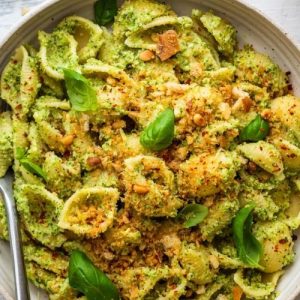This vibrant broccoli pesto pasta is a simple, nourishing meal that effortlessly combines flavor and health.
Packed with plant-based protein, fiber, and heart-healthy fats from nuts and olive oil, it’s low in saturated fat yet deeply satisfying.
Quick to prepare and versatile, it’s perfect for weeknight dinners, meal prep, or a wholesome lunch that keeps you energized.

15-Minute Flavorful Broccoli Pesto Pasta
Equipment
- Large Pot – 1
- Steamer basket – 1
- Small skillet – 1
- Food processor – 1
- Measuring cups (1 set)
- Measuring spoons (1 set)
- Wooden spoon (1)
- Knife (1)
- Cutting board (1)
- Serving bowls – 2–3
Ingredients
Broccoli Pesto:
- 350 g broccoli florets 1 medium head
- 35 g pine nuts ¼ cup, plus extra to serve
- 30 g fresh basil leaves 1 oz
- 1 garlic clove
- 30 ml lemon juice 2 tbsp
- Zest of ½–1 lemon
- 4 tbsp nutritional yeast optional
- Salt to taste
- Black pepper to taste
- 60 ml extra virgin olive oil ¼ cup, optional
Other Ingredients:
- 300 g orecchiette or similar pasta 10.5 oz
- 2 tbsp capers finely chopped (optional)
- Fried breadcrumbs to garnish (optional)
Instructions
- Toast the Nuts: Begin by heating a small skillet over low heat. Add the pine nuts, keeping them in a single layer to ensure even toasting. Stir frequently with a wooden spoon to prevent burning. Toast until they turn a golden brown and release a fragrant, nutty aroma. This step enhances their flavor and adds a lovely depth to your pesto. Once toasted, remove from heat and set aside to cool slightly.
- Prepare the Broccoli: Wash the broccoli thoroughly under cold running water and pat dry. Separate the broccoli into small, even florets. Don’t discard the stems—peel and slice them to use in salads or stir-fries later. This ensures nothing goes to waste and adds extra fiber to your diet.
- Steam the Broccoli: Fill a large pot with about an inch of water and bring it to a gentle boil. Place a steamer basket on top, making sure it doesn’t touch the water. Arrange the broccoli florets evenly inside the basket. Cover with a lid and steam for 3–4 minutes until the broccoli is tender but still bright green and slightly crisp. Avoid overcooking to maintain texture and nutrients. Once done, carefully remove the basket and set aside.
- Cook the Pasta: In the same large pot of boiling water, add a generous pinch of salt. Add your chosen pasta, such as orecchiette, and cook according to the package instructions until al dente. Reserve about ½ cup (120 ml) of the pasta cooking water before draining—this starchy water will help loosen the pesto and help it cling beautifully to the pasta. Drain the pasta and return it to the pot briefly, keeping it warm.
- Prepare the Pesto Base: Place the steamed broccoli florets into a food processor. Pulse a few times to break them down slightly, creating a coarse texture to start. This ensures the final pesto will have a smooth, creamy consistency but still retain some body.
- Build the Pesto Flavor: Add the toasted pine nuts, fresh basil leaves, peeled garlic clove, lemon juice, and lemon zest to the food processor. Sprinkle in the nutritional yeast (if using) and season with salt and freshly ground black pepper. Pulse several times until the mixture begins to combine. Taste and adjust seasoning gradually—lemon and salt can be balanced to your preference.
- Emulsify the Pesto: With the food processor running, slowly drizzle in the olive oil (or a combination of pasta water and tahini if making oil-free). Continue blending until the pesto achieves a creamy, spreadable consistency. Add a few tablespoons of the reserved pasta water if the mixture feels too thick; the starch in the water will help the pesto cling to the pasta beautifully.
- Combine Pesto and Pasta: Transfer the drained, warm pasta back into the large pot or a serving bowl. Pour the freshly made broccoli pesto over the pasta. Using a wooden spoon or silicone spatula, gently toss to coat each piece evenly. Ensure the pesto distributes throughout the pasta, with small bits of broccoli and pine nuts creating texture and flavor in every bite.
- Add Optional Enhancements: For extra bursts of flavor, stir in finely chopped capers. They add a subtle tanginess that elevates the overall taste. If desired, sprinkle fried breadcrumbs over the top to provide a crunchy contrast to the creamy pasta. These small additions are optional but highly recommended for a more complex and satisfying dish.
- Serve and Enjoy: Divide the broccoli pesto pasta into individual bowls or plates. Serve immediately while warm, ensuring each serving has a balanced mix of pasta, pesto, and any optional toppings. Pair with a light side salad or roasted vegetables if desired. Store any leftovers in an airtight container in the refrigerator for up to 3–4 days—reheat gently, adding a splash of reserved pasta water to restore creaminess.
Notes
- Broccoli Selection: Choose fresh, firm broccoli with bright green florets. Avoid yellowing or limp stems, as they may affect both flavor and texture. The stems can also be peeled and shredded to add extra fiber to the dish.
- Pasta Water Matters: Always reserve a bit of pasta cooking water before draining. Its natural starch helps thin the pesto, allowing it to cling beautifully to the pasta for a creamy, cohesive sauce.
- Nut Flexibility: While pine nuts are traditional, feel free to use toasted almonds, cashews, or pumpkin seeds. Each option adds its own flavor profile while keeping the dish nutritious.
- Oil-Free Options: For an oil-free version, substitute olive oil with avocado or tahini. Adjust the amount of reserved pasta water to achieve a silky texture without compromising creaminess.
- Nutritional Yeast Substitutes: If you don’t have nutritional yeast, try white miso or sun-dried tomatoes for umami flavor. Both work wonderfully to give depth without overpowering the broccoli.
Chef’s Secrets: Elevate Your Pasta Experience
To truly elevate this broccoli pesto pasta, start by gently toasting your nuts—the aroma released will transform the pesto’s flavor.
Steaming broccoli just until tender preserves both its color and crunch, creating a more appealing texture.
When blending the pesto, always pulse gradually rather than overprocessing; this keeps the sauce slightly textured, giving the dish a more artisanal feel.
A touch of pasta water or lemon juice can instantly brighten the flavors, making each bite fresh and lively.
Serving Suggestions: Delicious Pairing Ideas
This broccoli pesto pasta shines as a standalone main, but it’s versatile enough for creative serving.
Add a side of roasted cherry tomatoes or sautéed mushrooms for extra umami.
Sprinkle with fried breadcrumbs or toasted nuts for crunch, or garnish with fresh basil leaves for visual appeal.
For a more filling meal, serve alongside a mixed green salad with a light lemon vinaigrette, or accompany it with warm, crusty bread to soak up every bit of pesto.
Storage Tips: Keep Pasta Fresh Longer
Leftovers can be stored in an airtight container in the refrigerator for up to 3–4 days.
When reheating, add a splash of reserved pasta water or a small drizzle of olive oil to maintain creaminess.
The pesto itself can be frozen in ice cube trays; once frozen, transfer cubes to a sealed container.
This allows you to defrost small portions as needed, making weeknight meals quick and convenient without losing flavor.
Frequently Asked Questions
1. Can I use frozen broccoli instead?
Yes, frozen broccoli works well, but be sure to steam or cook it gently to avoid excess water, which can thin the pesto. Pat it dry before blending for best results.
2. Can I make this recipe vegan or oil-free?
Absolutely! The dish is naturally plant-based.
For oil-free preparation, substitute olive oil with avocado, tahini, or a bit more pasta water, keeping the sauce creamy and smooth.
3. What pasta types work best?
Orecchiette is ideal, as its cup-like shape holds the pesto well, but you can also use penne, fusilli, or farfalle.
Short, ridged pasta works best for clinging sauces.
4. How can I store pesto separately?
Store the pesto in an airtight container in the fridge for up to 5 days.
For longer storage, freeze in small portions using ice cube trays, then thaw as needed to prevent waste.
5. Can I add extra vegetables?
Yes! Roasted peppers, zucchini, or spinach can be stirred in when tossing the pasta.
Add them at the end of cooking to retain color and texture.

